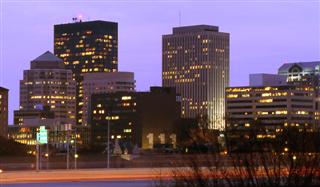
DAYTON, OH - Montgomery County looks to capitalize on growing environmental movement with a new task force aimed at parlaying green initiatives into economic development opportunities. Co-chairs of the MC-G3 task force, Michael Berning and David Williams, announced the launch of the task force Thursday to a crowd of about 120 business leaders at the Dayton Business Journal's 2008 Shades of Green Luncheon at the Dayton Convention Center.
The task force will focus on education, policy and economic development to create initiatives, incentives and benchmarks to encourage new green businesses in Montgomery County. A concentrated effort to stimulate green practices and tax incentives to green businesses could give the county a competitive edge in economic development and an opportunity to repurpose traditional manufacturing facilities and workers, Berning said.
Berning, director of sustainable practices at Kettering-based Heapy Engineering joined Williams, development partner for the Village of North Clayton, Shawn Hesse, chair of the U.S. Green Building Council's Cincinnati chapter, and Larry Brown, naturalist for the Aullwood Audubon Center, on a panel discussing environmentally friendly practices businesses can incorporate to save on costs and help the environment. "There are a lot of small steps businesses can take to go green," Hesse said. "It's a common misconception that it's an all or nothing decision, but it's a process."
Hesse suggested small changes such as switching to foaming soap, which lasts six times as long as liquid or lotion soap or changing office lighting to compact flourescents. Other changes such as cutting down on the use of paper or switching to a soda fountain instead of a pop machine can represent significant cost savings of thousands of dollars for a business, Berning said. "A lot of things you can do are not rocket science," he said.
If companies already have taken small steps, the panel recommended larger-scale changes such as upgrades to energy-efficient heating and cooling systems, insulation, increased ventilation and low-flush toilets to increase efficiency. But they advised research and proper education were important steps to take before tackling major changes. A good guide for correct changes can be found on the U.S. Green Building Council's Web site (usgbc.org), Hesse said. The council rates new and existing buildings for their environmental practices, giving out four levels of LEED certifications to buildings that incorporate the best practices.
The panel also discussed the misconception about the high cost of going green. The average cost to build a green is 2 percent above the non-green building, but the return on investment can equal up to 14 percent, Berning said. A lot of the misconceptions, Berning added, stem from a history of negative perceptions about those who choose to conserve. "There's been a lot of baggage over the years," Berning said. "But the perceptions are going away ... It's not going to be a fad, going green is here to stay."
Source: Dayton Business Journal